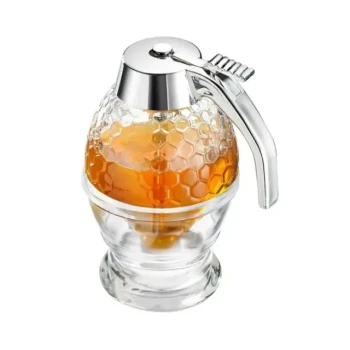For safe and effective honey processing, the recommended drying temperature is between 35-40°C (95-104°F), and the target final moisture content should be less than 18%. Exceeding these parameters can lead to fermentation or damage the honey's delicate enzymes and flavor profile.
The core challenge of drying honey is removing excess water to prevent spoilage without using excessive heat. The goal is to preserve the honey's natural quality, which requires a slow, low-temperature approach.

Why Moisture Content is Critical
Honey's low moisture content is the primary reason it is so shelf-stable. When moisture levels are too high, naturally occurring osmophilic yeasts can activate and begin to ferment the sugars in the honey.
The Risk of Fermentation
When the moisture content of honey rises above 20%, the risk of fermentation increases dramatically. Fermented honey will have a sour taste and smell and is considered spoiled.
The Ideal Moisture Target
To ensure long-term preservation and prevent any chance of fermentation, the ideal moisture content is between 17% and 18%. Some standards allow for up to 19%, but aiming for below 18% provides a crucial safety margin.
The Correct Temperature for Drying Honey
Heat is the most common tool for lowering moisture, but it is also the biggest threat to honey's quality. Applying heat correctly is a delicate balancing act.
The Optimal Drying Range
The safest and most effective temperature range for reducing honey's moisture is between 35°C and 40°C (95-104°F). This gentle warmth increases water evaporation without causing significant damage.
The Dangers of Excessive Heat
Heating honey above 40°C begins to degrade its sensitive enzymes and aromatic compounds. As temperatures rise toward 50°C (122°F) and beyond, this degradation accelerates rapidly, destroying the very properties that make honey valuable.
Understanding the Trade-offs: Heat, Time, and Quality
When drying honey, you are constantly managing a trade-off between the speed of the process and the quality of the final product.
The Problem with High Heat
Applying high heat will remove moisture quickly, but it comes at a significant cost. Excessive heat not only destroys beneficial enzymes like diastase and invertase but can also increase the levels of Hydroxymethylfurfural (HMF).
HMF is a compound formed from the breakdown of sugars in the presence of acid and heat. Its presence is a key indicator that honey has been overheated or is very old.
The Benefit of Low Heat and Airflow
A low-and-slow approach is always superior for preserving quality. Using gentle heat (35°C) combined with airflow from a fan or a dehumidifier is the professional standard. This method allows water to evaporate from the surface of the honey safely over several days.
Common Drying Methods
Effective drying involves increasing the honey's surface area and managing the air around it. This is often done by placing honey in shallow trays inside a small, warm room equipped with a dehumidifier to remove moisture from the air.
Making the Right Choice for Your Goal
Your specific goal will determine your exact parameters. Always use a honey refractometer to accurately measure moisture content before and during the process.
- If your primary focus is maximum preservation and quality: Dry your honey at 35°C (95°F) until the moisture content is confirmed to be between 17% and 18%.
- If your primary focus is balancing speed with acceptable quality: Use a temperature no higher than 40°C (104°F) and aim for a final moisture content of 18-19%.
Controlling temperature and moisture is the most important step in protecting the value and integrity of your final product.
Summary Table:
| Parameter | Recommended Range | Critical Threshold |
|---|---|---|
| Drying Temperature | 35°C - 40°C (95°F - 104°F) | >40°C (104°F) begins to degrade quality |
| Final Moisture Content | <18% (Ideal: 17%-18%) | >20% significantly increases fermentation risk |
Achieve Perfect Honey Quality with Professional Equipment
Precise temperature and moisture control are non-negotiable for producing high-value, shelf-stable honey. HONESTBEE supplies commercial apiaries and beekeeping equipment distributors with the reliable, wholesale-focused equipment needed for this critical process.
We provide the durable tools—like honey refractometers and efficient drying systems—that help you protect your product's integrity and maximize your yield.
Ready to optimize your honey processing? Contact our experts today to discuss the right equipment for your operation.
Visual Guide

Related Products
- Economy Small Scale Honey Dryer Dehumidifier Thickening Machine
- 0.5T Capacity Honey Dehumidifier Dryer with Vacuum Heating and Thickening Filtering Machine
- High Quality Honey Dehumidifier Dryer Thickening Machine for Beekeeping
- 8-Frame Electric Self-Reversing Honey Extractor Spinner for Commercial Honey Extraction Equipment
- electric honey extractor honey centrifuge 3 frame honey extractor stainless steel honey frame extractor
People Also Ask
- How can the moisture content of honey be reduced? A Guide to Safe, Effective Drying Methods
- Can you dehumidify honey? A Beekeeper's Guide to Preventing Fermentation
- How does a honey dryer remove moisture from honey? Achieve Perfect Honey Stability with Controlled Drying
- How does temperature regulation help in managing honey moisture content? Prevent Fermentation & Ensure Quality
- How to reduce moisture level in honey? Preserve Quality and Prevent Fermentation



















